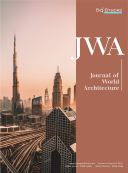Abstract
Beijing Xianyukou Hutong (hutong refers to historical and cultural block in Chinese) occupies an important geographical location with unique urban fabric, and after years of renewal and protection, the commercial space of Xianyukou Street and has gained some recognition. This article Xianyukou takes commercial hutong in Beijing as an example, spatial analysis was carried out using methods like GIS kernel density method, space syntax after site investigation and research. Based on the street space problems found, this paper then puts forward strategies to improve and upgrade Xianyukou Street’s commercial space and improve businesses in Xianyukou Street and other similar hutong.
References
Beijing Municipal People’s Government,1999, Notice on the Distribution of Beijing Old City Historical and Cultural Reserve Protection and Control Area Planning, Jing Zhengfa 24.1999.8.6.
Wang Z, Liu L, 2020, Spatial Morphological changes of Urban and Non-Protected Historic Districts from the Perspective of Space Syntax: A Case Study of Wenfeng Ancient Street Area in Hechuan. Journal of Southwest University (Natural Science Edition), and 2020(01): 142–150. https://www.doi.org/10.13718/j.cnki.XDZK.2020.01.020
Beijing Municipal Planning Commission, (ed) 2002, Protection Planning of 25 Historical and Cultural Reserves in Beijing Old City, Beijing Yanshan Press.
Gao Y, Lou J, 2019, Research on the Strategy of Fabric Darning in Old City Based on Style and People’s Livelihood: A Case Study of Beijing Xianyukou Historical and Cultural District. Proceedings of Vitality of Urban and Rural Human Settlements Good — 2019 China Urban Planning Conference (09 Urban Cultural Heritage Protection), 533–547.
Xu Z, Liang J, Xu W, 2021, Study on the Correlation Between the Shape of Road Network and the Spatial Layout of Retail Business in Fuzhou. Geomatics of Surveying and Mapping, 46(S1): 5–10. https://www.doi.org/10.14188/j.2095-6045.2019469
Zhai YJ, 2016, Spatial Organization Analysis and Design Management of Urban Parks Based on Space Syntax Theory: A Preliminary Study on the Method of Convex Map Analysis. Chinese Landscape Architecture, 32(03): 80–84.
Liu X, Xu S, 2021, Spatial Optimization of Historic Urban areas Based on Space Syntax: A Case Study of Daowai District in Harbin. Architectural technology at low temperature, 2021(02): 1–4 + 9. https://www.doi.org/10.13905/j.cnki.DWJZ. 2021.02.001
Zhou J, Zhang J, 2018, Spatial Morphology of Historic District Based on Space Syntax: A Case study of Qianmen District in Beijing. Journal of Beijing Union University, 32(01): 22–27. https://www.doi.org/10.16255/j.cnki.LDXBZ.2018.01.004
Li C, Liu X, Qi T, et al., 2021, Study on the Optimization Strategy of Street Commercial Space in Pingyao Ancient City Based on Space Syntax Theory. Urban Construction, 17(4): 99–104. https://www.doi.org/10.19892/j.cnki.CSJZ.2021.04.24
Gao J, Liu C, Bai Y, et al., 2021, Based on the Space Syntax of Pingyao Ancient City Space Form Study. Journal of Urban Architecture, 18(4): 83–87. https://www.doi.org/10.19892/j.cnki.CSJZ.2021.04.20
